As a marketer, your goal is to grow brand awareness and sales, while keeping customer acquisition costs low. DTC marketing is a superb way to do that.
While partnering with big retailers has its benefits, DTC brands experience several advantages by owning their own marketing channels:
- More control over product branding, positioning, marketing, and distribution channels
- First-party data on customers, so you better understand who your buyers are
- Faster time to market to launch new products at lower prices
- Higher margins, because you don’t need to sell products to retailers at a discount
DTC brands are more proactive when it comes to their marketing efforts. They don’t have the built-in audiences mega-retailers like Walmart can offer. So they use various strategies to promote themselves, such as influencer marketing, SMS marketing, communities, and email.
Ready to get in on the action? This guide shares how to create a successful DTC marketing strategy , with ideas and examples to get you started.
Table of contents
- What is direct-to-consumer (DTC) marketing?
- Benefits of DTC marketing
- Examples of successful DTC brands
- Top DTC marketing strategies
- Direct-to-consumer marketing strategy tips
- Direct-to-consumer marketing trends
- DTC marketing FAQ
What is Direct-to-Consumer (DTC) marketing?
Direct-to-consumer (DTC) marketing refers to any tactics used to promote products directly to consumers versus through a retail business. A brand like Everlane, for example, could work with brands like Walmart or Amazon to promote its products. Instead, it advertises its products to potential customers, completely cutting out the middleman.
Benefits of DTC marketing
More control over branding
You want to have control over how your product and brand are represented in the market. Marketing DTC products is the unique intersection of your value proposition, branding, and messaging that no one else can compete with.
Lexie Becker, a brand partnership specialist at Fifth & Cor, a Shopify partner, explains, “You can approach marketing in whatever way you choose and drives the most sales while creating a loyal customer base. Customers aren’t comparing you to who is sitting next to you on a shelf. They’re looking at you and how you can benefit them.”
Higher profit margins
Business models that operate DTC offer the opportunity to maintain higher profit margins. By producing and marketing your own product, you keep more money in your business rather than sending it to suppliers.
“The DTC model advantages are primarily centered around highly measurable unit economics that can be scaled via digital channels to build brand awareness and acquire a high volume of customers,” says Alex Song, founder of AI targeting solution Proxima.
“This also includes superior gross margin due to the removal of wholesalers that traditionally take a sizable chunk of profits in traditional retail. The transparency into digital channels also creates greater confidence in how capital is being spent, which is especially valuable in a recessionary environment.”
Data-driven marketing decisions
Stephen Light, founder of DTC mattress retailer Nolah, feels that “data is king when it comes to the strongest marketing campaigns.” In his view, DTC marketing offers far more access to first-party customer data compared to working with retailers.
DTC brands get access to data like:
- Web browsing behavior
- Subscriber data
- Social media data
- Purchase information
- Cross platform data
- Surveys
- Feedback
- CRM information
This information helps you understand the customer journey from end to end, so you can build more personalized marketing campaigns that result in sales.
Challenges of DTC marketing
While DTC marketing has its benefits, it’s important to look at the drawbacks.
- DTC requires an upfront investment if you’re entering a new market. You’ll need a good amount of capital to run prospecting campaigns and build awareness for your company. There are no pre-built audiences like when going through a retailer.
- DTC brands also hold more liability risk. If you don’t attract customers or can’t promote your product well enough, there is no one else to blame.
Selling direct to consumers makes the supply chain complex. There are various points of vulnerability that could disrupt the business. Rather than make a few shipments to a few vendors, you are responsible for shipping thousands of orders to consumers’ doorsteps.
Examples of successful DTC brands
One of the best ways to learn is by example, so let’s dig through some of our favorite DTC brands to show off how they’re marketing to their customers.
1. Magic Spoon
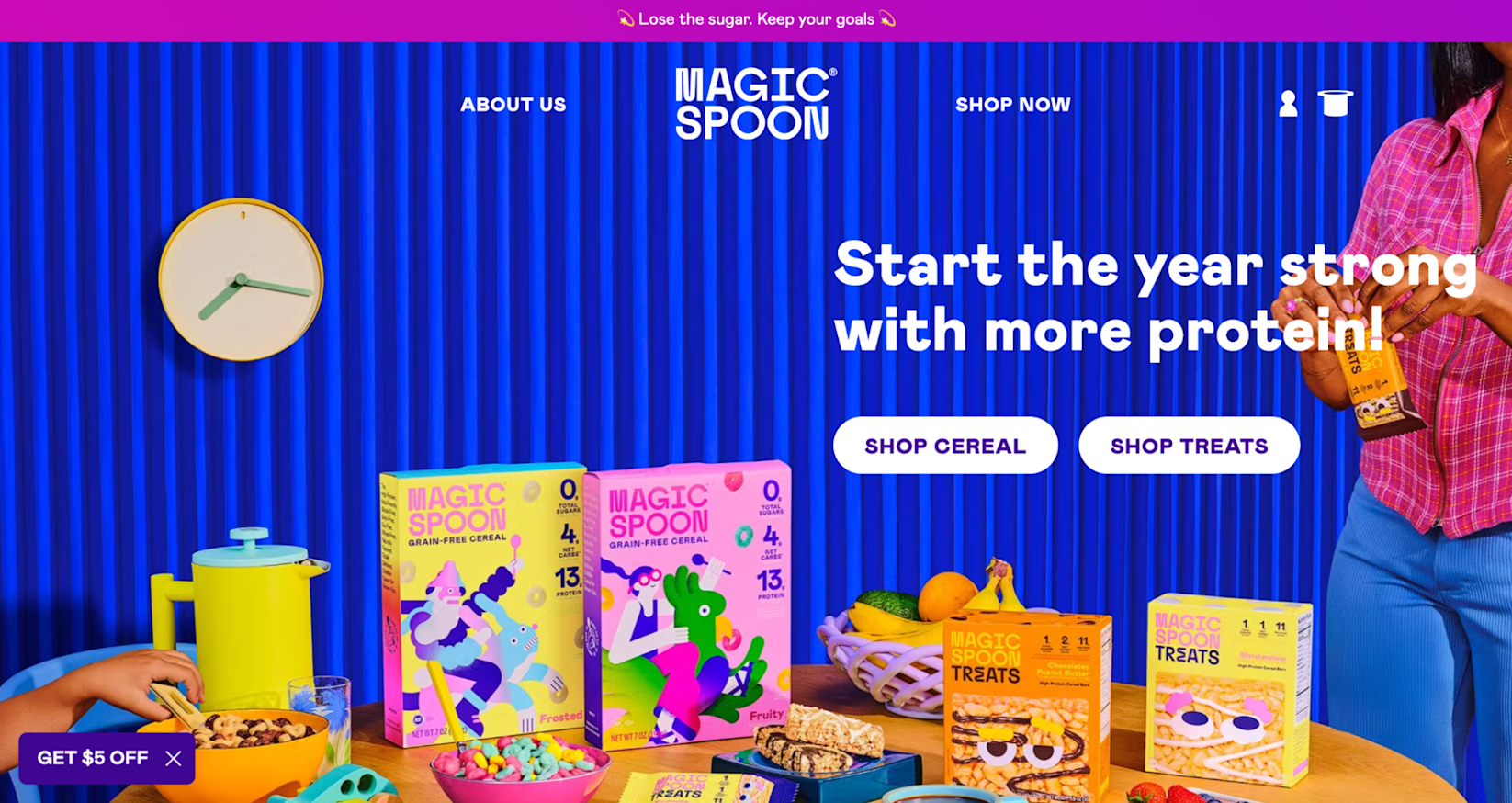
Magic Spoon is a healthy cereal company with bright, bold branding. It has a presence on social media platforms like Instagram, Facebook, and Twitter, while also building an email list and promoting an affiliate program.
Consumers can browse through its cereal options and order online, while also having the option to subscribe. With Magic Spoon’s subscription model, customers receive four boxes of cereal per month at a discounted rate than if they were to buy one-off boxes. This strategy gives the company a longer customer lifetime value plus guaranteed recurring income from subscribers.
Its marketing strategy utilizes abstract product photos against bright backgrounds and incorporates bold patterns—another nod to its brand identity.
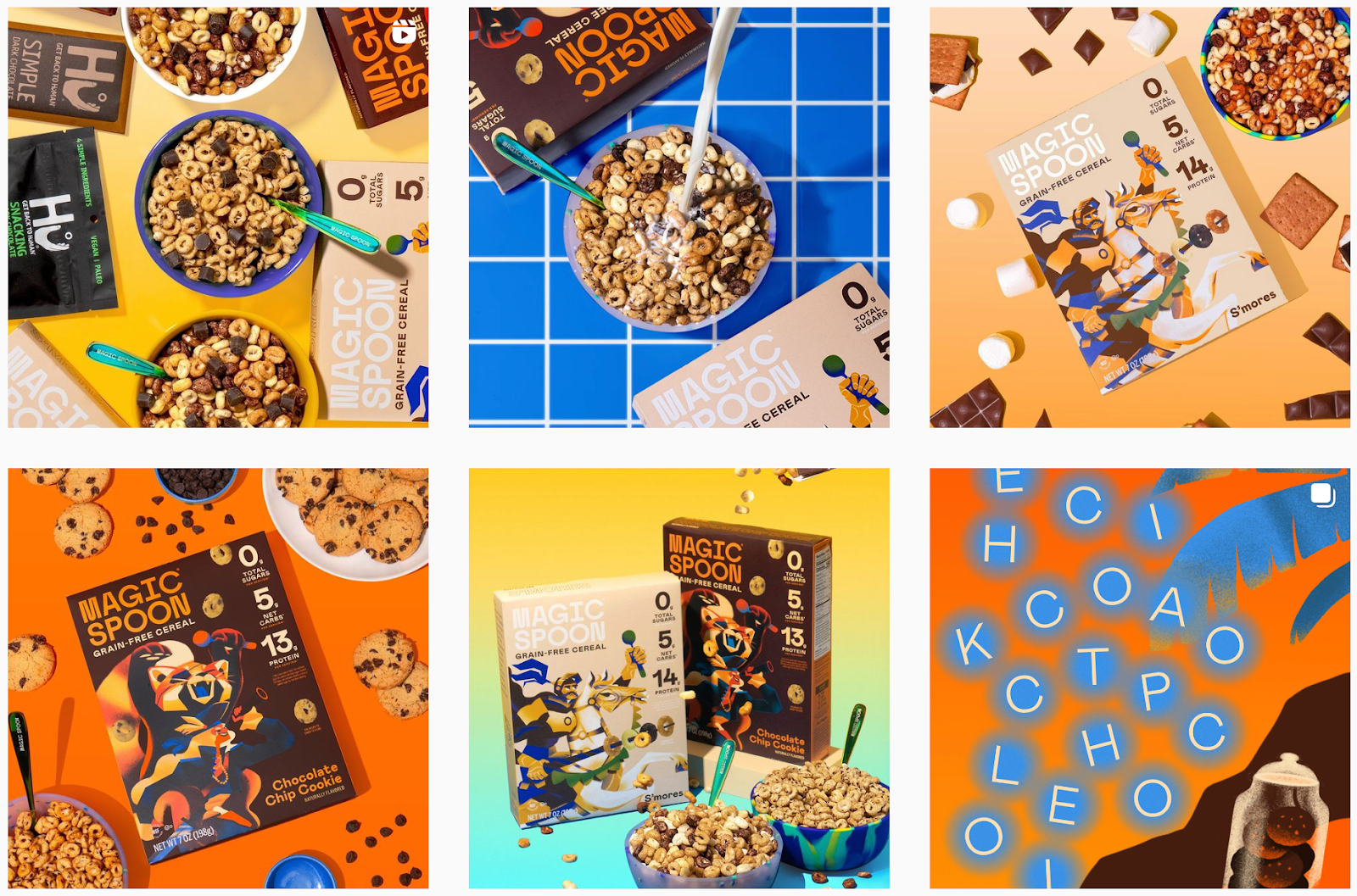
Its captions are short and sweet, letting the food pics do most of the work. And it’s obviously working, too. Magic Spoon was founded only in 2019, and in June of 2022, the company raised $85 million in funding.
2. MeUndies

MeUndies is the self-proclaimed “world’s most comfortable underwear.” With such an intimate product, it can be difficult to find the right voice for your brand, but MeUndies has nailed it with its supportive and humorous approach.
Its marketing strategy takes it to many different channels, with its social presence expanding across Twitter, Facebook, YouTube, Instagram, Pinterest, and even Snapchat.
However, it also created a smart tactic for building up its email list: a website pop-up that offers a discount code the second someone lands on its site.
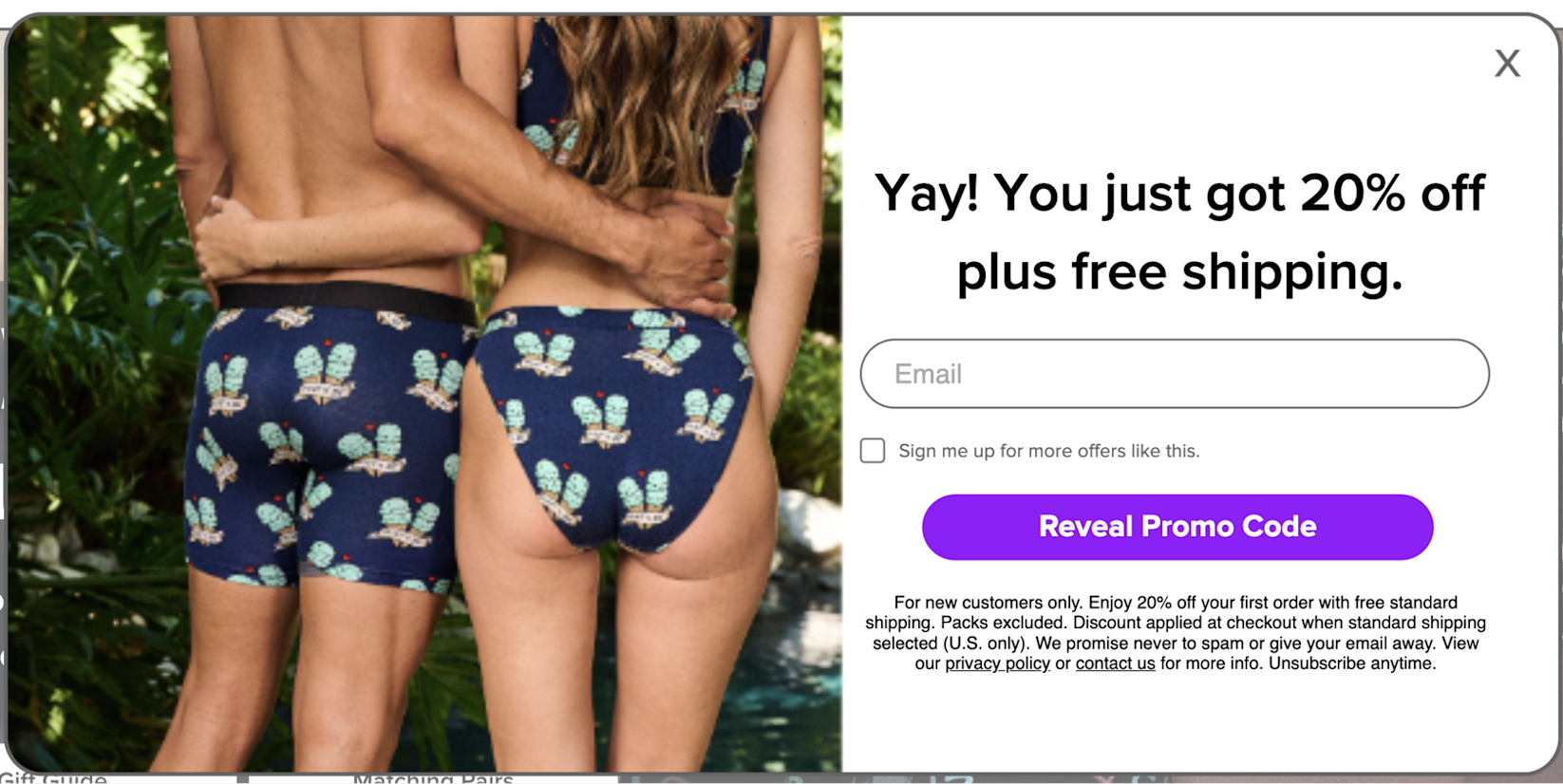
It specifies that the offer is for new customers only, helping to increase its overall customer base. Plus, like we saw with Magic Spoon, MeUndies offers its own membership option, where customers can subscribe to receive one new pair of underwear, bralette, or socks each month.
The company is currently pulling in an estimated $31 million per year, staking its claim in the underwear industry as one of the most successful brands. And it’s doing it all as a DTC brand.
3. Chubbies
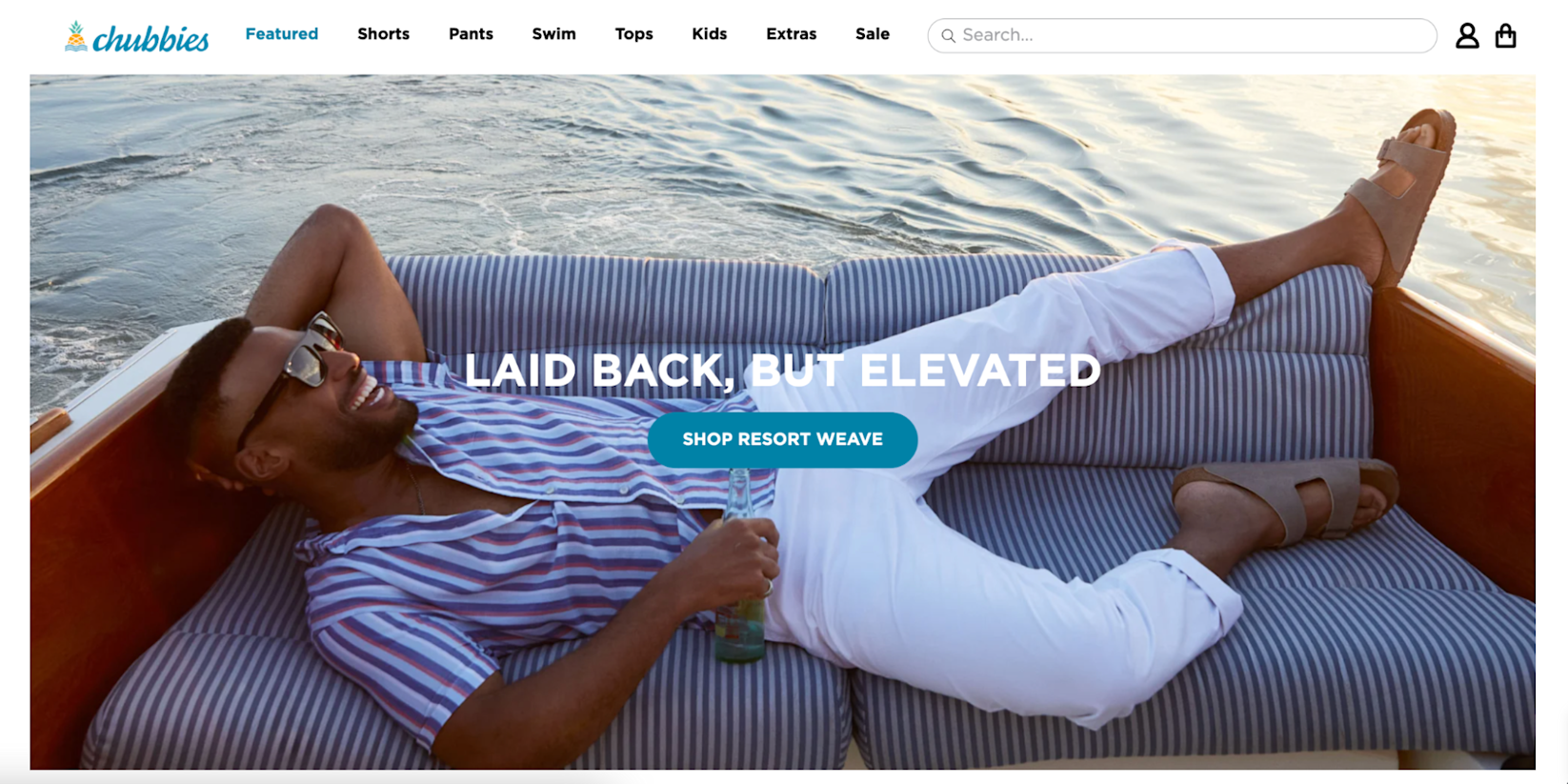
Chubbies is a menswear brand known for its “short shorts” for men—meaning it sells shorts with a four-inch, five-inch, and seven-inch in-seam. The company was founded in 2011 after the founders (four college friends) could only find short shorts in old thrift stores, the style having been left back in the ’70s.
However, Chubbies was well ahead of its time, with the shorter style seamlessly popping back into fashion over the past decade. The brand has a presence on social platforms like Facebook, Instagram, YouTube, Snapchat, and TikTok.
<u>https://www.tiktok.com/@chubbiesshorts/video/7308783323877510446</u>Through its social presence, Chubbies is immediately establishing its niche—clothing meant for fun, outdoorsy activities typically done on the weekend. By keeping consistent messaging, it’s able to build a strong brand that resonates with its target audience—men who want to have fun on weekends without being constrained by long shorts.
4. Away

Luxury travel brand Away gives us another great example of DTC marketing. Its social media presence extends across platforms like Instagram, Facebook, Twitter, and Pinterest, smartly setting up the online shop that each platform (not including Twitter) provides for ecommerce brands.
However, the real gem of its online marketing is its Twitter presence, where it tweets relatable content about traveling and packing:

And as you can see, for organic content, it sees some consistent engagement from its followers. This type of content is perfect for Twitter, one of the only platforms where a simple copy-only post can perform well.
Its Instagram provides fun content its audience loves, finding a happy medium between product photos and feel-good user-generated content.
5. Personal Fav

Personal Fav is a sexual wellness brand that sells plant-based and CBD lubricants. As a brand in the sex industry, Personal Fav has a lot of social stigma to work through in its marketing—but it does a great job by promoting body and sex positivity, as well as sex education.
Personal Fav has a brightly colored brand identity that we see across all of its digital marketing channels, along with a confident and cheeky voice. But because sex education isn’t widely accessible, it does a great job of promoting informational tips for getting the most out of its product—safely.
Here’s an example of what one of these posts might look like on its Instagram.
And here’s an educational video it shared on its TikTfok.
With a product like this, Personal Fav has no choice but to be shamelessly open, helping to show that there should be no stigma surrounding sex and pleasure.
If you’re also in a stigmatized industry, having a bold voice that educates your audience and empowers your customer can help you succeed.
6. Pomp
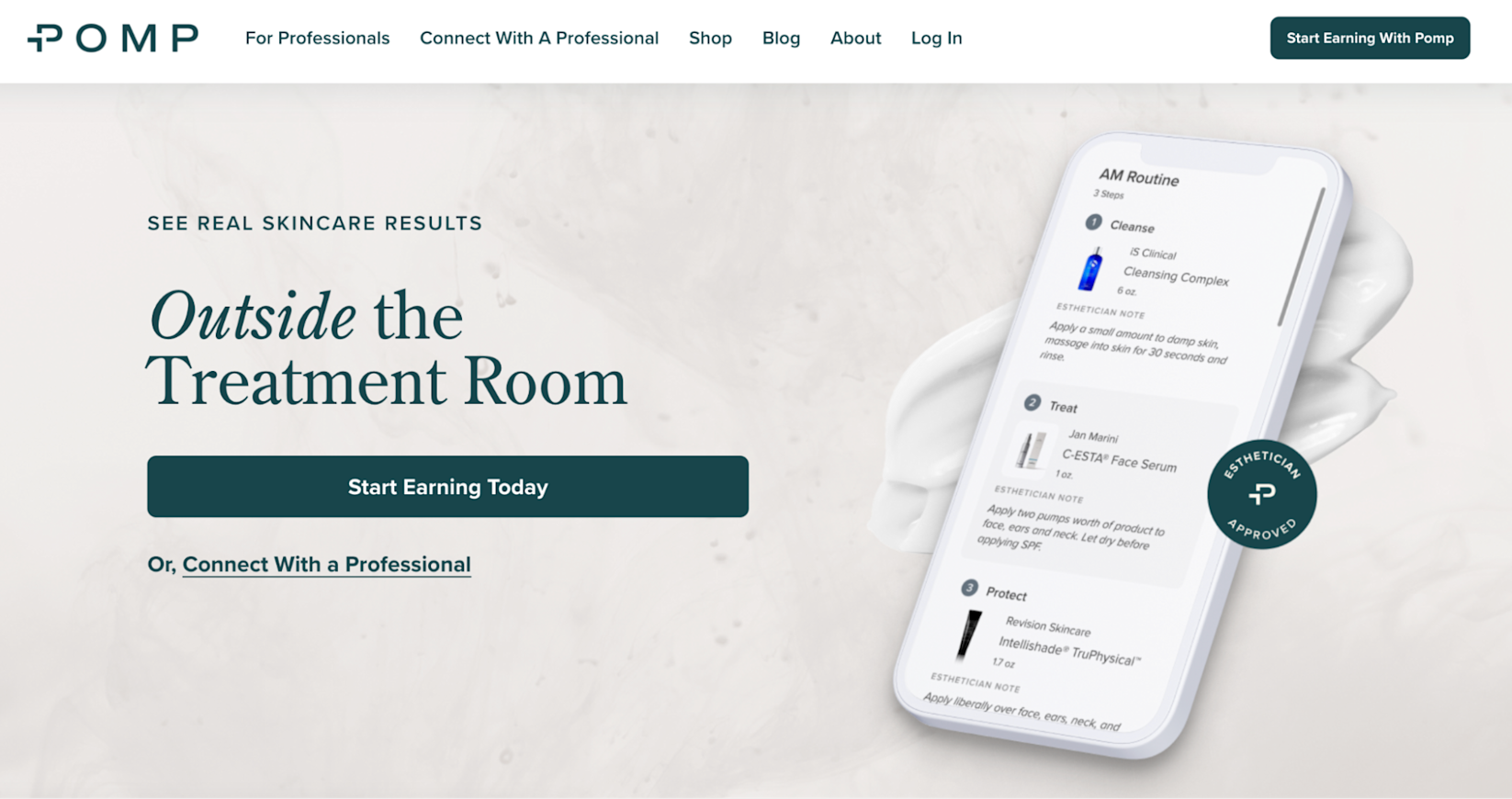
Skin care brand Pomp has personalization in the bag. By starting its customer journey with a survey, it’s able to help people find the exact right products for them.
Because the entire company revolves around personalized skin care recommendations, its marketing messaging also focuses on skin care education for its customers.
Here’s an example of some of the content you’ll find on its social channels
Its personalization is a huge selling point, helping it create a marketing strategy surrounding it that immediately resonates with customers.
Top DTC marketing strategies
Different marketing channels work well for different brands. For example, the social media platform LinkedIn is prime for B2B companies, while Pinterest helps ecommerce brands kill it.
There are six major marketing channels that work well for DTC brands. Learn more about each one and gather inspiration from each of our examples.
Social media marketing
Social media platforms are going to be one of the best ways to reach new audiences for your DTC brand. From social media advertising to organic reach, this channel can work for your entire marketing funnel, from brand awareness all the way down to conversion.
A few of the top social media platforms for DTC brands are:
- TikTok
According to Andrew Campbell, Head of Data Science at OpenStore, “Facebook Ads remains the easiest and fastest way for new DTC brands to test ideas. With the platform, new DTC brands can run scientific experiments to discover the things about their business that resonate most with customers. Once a new brand finds its true product-market fit, it is a magnitude easier to compete in ad auctions, create compelling landing pages, and explore emerging channels, like TikTok.”
Let’s take vitamin company Ritual, for example. It has an ad library full of Facebook and Instagram ads that introduce the brand to potential new customers, as well as inform existing customers of new product launches.
But on its own Facebook page, it also shares creative content and relevant memes to further engage its audience.
Because it’s able to manage its own brand messaging, it has the luxury of using marketing channels like this in unique and creative ways.
Email marketing
Another huge channel for DTC brands is email. But that doesn’t mean you need to start sending email after email after email, or you’re going to get feedback like this:
https://twitter.com/mrsharma/status/1201700436929105920Instead, use email marketing to enhance the value of your other marketing campaigns. Promote sales on social media that you remind customers of via email, or create emails around campaigns that you’re also working with influencers on.
Email marketing is a great way to stay top-of-mind for potential customers. After all, customers may not buy something right after they discover you on social media or see an influencer recommend you, but they might after they see another ad or an email come through.
Here’s an example of an email newsletter from boutique furniture brand Edloe Finch promoting its chairs:

By using inviting product photography and email copy, it’s enticing interested customers to check out its website again, potentially leading to a new purchase.
Influencer marketing
Influencer marketing is becoming more popular each year, with no signs of slowing down. In fact, Statista cites that brands spent over $34 billion on influencer marketing in 2023.
Influencer marketing involves partnering with a celebrity or public figure to endorse a product. The market is moving quickly—there are influencers for every niche and sub-niche, including nano-influencers, kid influencers, and even computer-generated imagery (CGI) influencers. The rise of TikTok throughout the pandemic has also led to an increased number of everyday influencers, so brands need to adapt their strategies accordingly.
Influencer marketing plays a big role in DTC marketing success. It helps brands build awareness, content, and sales. On average, brands see around $4.12 on every $1 spent on influencer marketing.
Read more: Influencer Marketing: How to Build a Profitable Influencer Program Without Sacrificing Revenue
Here’s an example of what this could look like: Influencer Shelby Roebock, also known as Pretty in the Pines, shared this sponsored Reel as part of a paid partnership with brand Sonos, promoting a discount code to help her audience save money on their own Sonos purchase.

Personalization
Consumers are more likely to buy from brands that provide a personalized experience by showcasing products hyper-relevant to their needs. And with the technology available to us, it’s an important channel to invest in.
There are many different ways to personalize your customers’ experiences, from showing similar products on a product page to creating a profile that holds data about your customers’ purchasing behavior on your website.
Beauty brand IPSY does something similar to the latter by asking new customers to take a quiz based on their preferences. To start off, the first question asks about the customer’s skin tone to ensure that any foundations or concealers sent out match properly.

It then keeps this information in each user’s profile and uses it when sending out each month’s five-product subscription box to ensure it’s sending out products that are personalized to each of its subscribers.
Community building
Building a community around your brand is a huge feat. If you’re able to create an online community of dedicated fans who rally around and love your brand, you’ve done something really special. But it’s always a good idea to try.
There are many different ways to build a community, whether you create a Facebook group for customers, put together an affiliate program, start a forum surrounding your brand, etc.
Baby sling company WildBird has a Facebook community for its customers to talk to other parents and ask questions, get help and advice, and connect with people on the same journey. Consider creating a similar community so your customers have something to bond over that relates back to your brand.
SMS marketing
One newer marketing channel that is taking the world by storm is text SMS marketing. So many brands are asking for personal mobile phone numbers to send short marketing messages, updates on product launches, reminders of sales and discounts, and more.
Soap company Mr. Squatch dove into SMS marketing and has also seen great results—in fact, it reports that 15% of its $200 million in revenue comes exclusively from its SMS campaigns.
Word-of-mouth marketing
Using word of mouth as a marketing channel, direct-to-consumer brands can encourage their customers to tell others about their products and experiences.
Loyal customers can be rewarded for leaving reviews or sharing the brand on social media, or they can be created by providing exceptional customer service and creating a positive brand experience they will share with family and friends.
Direct-to-consumer marketing strategy tips
Because DTC companies are continuously popping up, the competition is fierce. In order to stand out, follow along with these best practices.
Create a strong brand identity
Good branding leads to brand recognition, a key component in your company’s success. When customers recognize a brand, they’re much more likely to be loyal to that brand.
So your first step is to create a strong brand identity. This typically consists of:
- Logo
- Colors
- Fonts
- Voice and messaging
- Packaging
By creating a brand identity that is visually appealing and resonates with your target audience, you’ll be able to stand out against competitors and build up a solid customer base.
Lexie Becker, Brand Partnership Specialist at marketing agency Fifth & Cor, says, “When it comes to DTC marketing, at Fifth & Cor, we recommend putting together a strong team who can evaluate your current brand identity and determine what needs to be done to see improvement.”
The Fifth & Cor team helped a DTC shoe brand do just that. According to Becker, “By creating a new Instagram visual brand strategy, they helped the company determine what their target consumers would respond to and, in result, decided to incorporate user-generated content, shoppable social commerce, and reputation management to drive substantial gains within the social ecosystem. As a result, they saw their conversions increase 220% in just 90 days.”
Putting emphasis on your own brand identity can generate similar results.
Build out your buyer personas
Who is your target customer? This is important information when building a DTC marketing strategy. After all, if you’re creating marketing messaging for the wrong audience, your strategy is going to flop.
Stephen Light of mattress brand Nolah says, “A deep understanding of your target audience—their needs, wants, behaviors, and more—shapes practically every other marketing decision you’ll ever make, and without it, your strategy is likely to be vague and aimless.”
The problem is that too many brands create superficial buyer personas that don’t actually tell them who their target audience is. Yes, you want some basic demographics, like age, gender identity, and income, but you also need to dig deeper.
Consider putting together a customer survey that you send out to your email list, or even working with a market research firm to help build your buyer personas. This will give you information like which marketing channels your target audience uses, what their buying patterns are, and how they feel about your product or industry as a whole.
Using this information will then provide you with the data on where to build your online presence and what type of messaging is going to resonate with customers and entice them to make a purchase.
Diversify your marketing channels
Diversifying your marketing channels helps you reach as wide an audience as possible. Sure, there are over two billion monthly active users on Facebook, but that doesn’t mean you want to stop there.
The marketing rule of seven tells us that the average consumer needs to hear a brand’s messaging around seven times before they’ll make a purchase. You’re more likely to make this happen by putting out content, advertising, and other marketing messaging across many different touchpoints.
In addition, relying on one channel (i.e., putting all of your eggs in one basket) can be a costly mistake.
Andrew Campbell, Head of Data Science at OpenStore, says, “Our OpenStore data shows that small Shopify merchants have seen the cost of impressions on Facebook rise by 25% over the past year and 100% over the past two years. In this competitive climate, the best brands will diversify their customer acquisition strategies and extend customer lifetime value through retention channels like SMS, email, and direct messaging on social media.”
Take a look at the buyer personas you’ve created and make sure you have a presence on the most prevalent platforms that your audience frequents.
Take advantage of digital advertising
One of the reasons social media marketing is so popular is because of its organic and viral potential. However, it can take time to build up an organic following and reach.
This is where digital advertising comes in. We’ve already mentioned that to see success with your DTC company, you’ll need a good bit of capital. A lot of that is going to go toward digital advertising campaigns, especially while in the startup stages.
Ads can work for any stage of the funnel, whether you’re reaching potential customers for the first time or you’re retargeting website visitors to get them to come back and make a purchase.
To get the most out of your advertising, Robert Eppinger with MaxAd says it’s important to leverage broad audiences.
In his words, “With new privacy frameworks in place, most audience segments previously utilized with success are now too small to facilitate ad account learnings in Facebook/Meta’s platform. Likewise, and less talked about, Google’s changes to match types mean broad match keywords controlled with manual bids and negative keywords are now a critical component of every ad account and regularly outperforming.”
Test different audiences, ad creative, and ad copy to find out what works best for your brand.
Get creative with your marketing content
As you’ll see in the next section, as we introduce you to a few examples of great DTC marketing, creativity is essential. There is so much content online, in our inboxes, and on our phones that mediocre promotional content is going to be ignored.
Eppinger says, “Creative messaging and copy are more critical than ever. Running different hooks and offers to these broad audiences forms the basis of the most effective way to target, giving an algorithm the scope to find prospects most likely to convert.”
One of the best ways to create content is to consume a lot of content. See what competitors are posting, and think of how you can do better. Look at what content creators and influencers are posting, especially if their audiences align with yours. Pay attention to trending topics, online memes, and other challenges that pop up that might relate to your industry.
Consuming a lot of online content and looking to see how the audience is receiving that content can be great inspiration for creating your own unique marketing content.
Direct-to-consumer marketing trends
Social commerce
Social commerce has skyrocketed in recent years, allocating over $67 billion in US sales in 2023. Platforms like Instagram, TikTok, and Pinterest are making it easier for brands to sell goods on the social platforms themselves.

Source: eMarketer
Much of this trend is driven by mobile shopping. Mobile ecommerce sales reached $2.2 trillion in 2023, and make up 60% of all ecommerce sales around the world. As people grow more comfortable buying on social platforms, DTC brands are investing more in it.
Here are the top shopping features available by social ecommerce platforms so far:

An analysis by Modern Retail found that out of the four measured platforms (Facebook, Instagram, TikTok, and Pinterest), Instagram had the highest number of brands using social commerce features, while TikTok had the lowest.
Video content
Video content has become the foundation for DTC marketing. Whether you’re creating catchy TikTok videos or running video ads, the majority of marketers (88%) value video marketing as an important part of their strategy. For newly launched DTC startups, TikTok has become the main place to find new customers.
Consumers also feel video is the most helpful form of content. Done well, video can help consumers envision themselves using your products and encourage sales.
But what types of video content are D2C brands creating? Here are four:
- Behind the scenes, which show how products are made and the company operates
- Employee profiles, which gives the backstory for different employees
- Product demos that show your products in action
- User-generated content that shows customers using your product
“Social platforms and consumers alike are steadfastly switching over to favoring video content,” says Lexie Becker, Brand Partnership Specialist at Fifth and Cor, a Shopify Partner. “Whether that be a company devoting more resources to their TikTok account or Instagram showing mainly Reels in the algorithm, video content is heavily preferred by consumers.
“With video content, you can see a product in use and the content overall stands out. This was seen to be true when a hair-care brand gained $15,000 in revenue after one TikTok post from a devoted customer of theirs.”
When it comes to DTC marketing, video content can help build social proof and credibility for your brand.
Brand partnerships
Another trend in the DTC space is brand partnerships, collaborations between brands with products/services that complement each other without being direct competitors. DTC startups in general have been embracing partnerships recently as a cheaper way to acquire new customers, compared to running Facebook and Google Ads.
“Brand partnerships can mean a massive increase in credibility, visibility, and value to each company’s image,” says Stephen Light, founder of Nolah. The point is to share each other’s audiences in the hopes of acquiring customers for less, and lately, DTC brands have been including partnerships as a consistent fixture of their marketing strategies rather than an intermittent venture.
“Brands can take advantage by reaching out to potential partners that align with brand image and values, and by ensuring that they’re offering something truly valuable to the other company. Brand partnerships are best when they’re based on real, authentic connection, and when it’s a win-win scenario on both sides.”
Adoption of BNPL and flexible payment options
Shopping cart abandonment is a common problem for ecommerce brands. With rates as high as 70%, DTC brands need to find ways to reduce cart abandonment to improve profitability. One way to do this is by offering a Buy Now, Pay Later (BNPL) payment option. These services boomed in 2023 through companies like Affirm and PayPal, reaching over $64.9 billion through November.
Customers love BNPL options because they can receive their orders by paying a fraction of the cost. With Shop Pay Installments, for example, customers can split purchases into regular payments over time. An added benefit, Shop Pay lifts conversion by up to 50% compared to guest checkout, and outpaces all other accelerated checkouts by at least 10%
DTC brands offering offline experiences
Digitally native brands are charting out a brick-and-mortar strategy to build awareness and sell products, whether it’s through a retail storefront or pop-up shop.
DTC darling Brooklinen is a great example. The linens company, launched in 2014, has shifted its acquisition strategy, focusing on opening retail locations in trendy areas. In summer 2022, the brand launched three high-end housewares stores in Portland, Santa Monica, and Philadelphia. They’ve continued opening stories since in cities like Chicago, Washington DC, San Diego, and San Francisco.
Josh Illig, Brooklinen’s VP of Retail, told Modern Retail, “Anytime we open up a physical store, not only do we see that driving business within that market, but we also see a bump in ecommerce sales.” The store gives customers an interactive experience with the brand’s expanding houseware line that shoppers can touch and see.
Start marketing your DTC brand today
From influencer marketing to SMS, there are many ways to market a DTC brand and increase sales. There are some challenges— like building an omnichannel presence and investing in resources upfront—but the key is using first-party data to personalize the experience for each customer.
Overcome their objections and doubts, create strong customer relationships, and take advantage of the latest trends. Soon you’ll see the benefits of more sales, higher profit margins, and better customer retention from marketing your DTC brand.
DTC marketing FAQ
What is DTC growth marketing?
Direct-to-Consumer (DTC) growth marketing refers to strategies and tactics used to increase revenue and expand the customer base. It uses digital channels and analytics to connect with consumers directly, often involving social media campaigns, personalized marketing, and data-driven advertising.
What is a DTC marketplace?
A DTC marketplace is a platform where Direct-to-Consumer brands can sell their products directly to customers without intermediaries.
Is B2C the same as DTC?
B2C, which stands for business-to-consumer, means selling products through an intermediary like a big box store. DTC stands for direct-to-consumer, meaning products and services are sold directly to consumers without third parties.
What is the DTC approach?
A direct-to-consumer business model eliminates the need for wholesalers and physical stores to sell your stuff to consumers. With a strong online presence with an emphasis on e-commerce and direct marketing, you're able to control the brand experience and customer loyalty.






